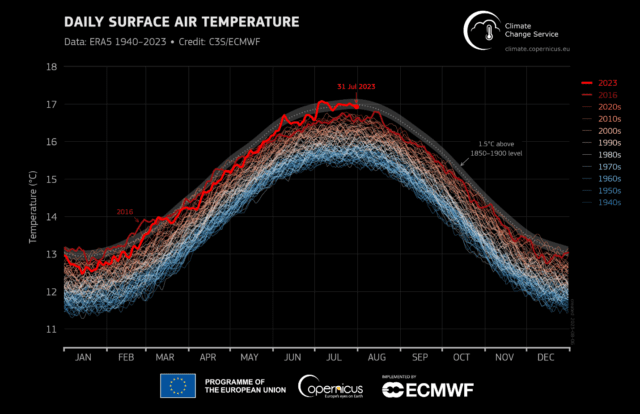The impacts of climate change are affecting much of the world, including the UK. There are obvious disruptions across multiple facets of life, affecting individuals, communities, and the larger economy. Unfortunately, there is growing concern that the country is inadequately equipped to address the challenges., including those to come.
Data from the Copernicus Climate Change Service showed that July 2023 set a new record as the hottest month globally, with an average global air temperature of 16.95 degrees Celsius temperatures exceeding the 1.5-degree Celsius limit set by the Paris Agreement. On July 6, 2023, the earth reached its highest recorded temperature, averaging 17.08 degrees Celsius.

Source: Copernicus Climate Change Service
Nonetheless, June of 2023 marked an unprecedented milestone for the UK as the hottest since records began in 1884. This record-breaking heatwave was primarily attributed to a surge in mid-month temperatures, culminating in an average temperature of 15.8°C for June 2023 – significantly surpassing the historical average by 2.5°C. At the outset of the month, a high-pressure system prevailed, resulting in temperatures that initially aligned with the seasonal norm. However, as this high-pressure system gradually waned, warmer and more humid air masses began to influence temperatures, eventually leading to the highest recorded temperature of 32.2°C.

Source: METOffice
These extreme heat events have raised concerns about the country’s preparedness for hotter summers. A Making Climate Adaptation Matter report reveal widespread concern among the British public regarding climate change impacts in the UK. A majority of people anticipate adverse effects on nature, public health, and insurance premiums, with a significant portion expressing worries about potential personal consequences. Alarmingly, only a mere 4% of respondents believe that the UK is adequately prepared for hotter summers, with a contrasting 45% holding the opposite view. These concerns also extend to doubts about the readiness of critical sectors.
Despite the prevailing concerns, there is undeniable evidence that people in the UK have been actively involved in endeavours to address climate change, reflected in their attitudes and actions. Presently, household energy consumption in the UK has witnessed a 9% reduction since 1990, following an initial increase in the early 2000s. Additionally, there has been a noticeable surge in the number of properties obtaining Energy Performance Certificates (EPCs) rated as band C or higher, indicating a substantial 19% increase since 2008 when EPCs became mandatory for residential properties.
Now that we’ve examined the present circumstances, let’s delve into the weather forecasts for the UK in the remaining months of 2023 and consider the elements that could impact these predictions.
Winter temperature trends
One of the most significant factors in weather predictions is temperature. In 2023, the UK is expected to experience some fluctuations in temperature. As the summer ebbs out, insight about the coming winter will be most significant. Based on available information, the UK winter for 2023-24 is predicted to be generally drier compared to previous winters. This prediction is based on the shift from a La Niña to an El Niño phase in the Equatorial Pacific. El Niño phases tend to bring colder and drier winters to the UK. Additionally, it’s noted that El Niño years typically have a milder and wetter start to winter (November-December) followed by a colder and drier end to winter (January-March) across most of northern Europe, including the UK. So, it appears that the UK can expect a colder and potentially snowier winter for 2023-24.
Autum precipitation
Warning signals have been raised for a sudden surge in temperatures in the upcoming months, which is poised to usher in an unusual two-month-long heatwave for the autumn season. Autumn in the UK for the remainder of 2023 is defying expectations with a surprising warmth, driven by a persistent high-pressure system over Europe. Projections indicate a 30% likelihood of a warmer-than-average autumn, influenced by global climate warming and elevated sea surface temperatures. Precipitation forecasts also suggest a 65% chance of near-average rainfall and a 70% chance of near-average wind speeds due to high-pressure systems. November may bring above-average rainfall, while September and October remain close to the seasonal norm. In summary, the UK’s autumn in 2023 is expected to be warmer than usual with typical precipitation patterns, offering the possibility of some Indian summer-like periods.
What should be the right responses?
To address climate change and prepare for its impacts, people in the UK should be willing to scale up actions. These include reducing carbon footprints through energy-efficient practices, adopting renewable energy sources, conserving water, and practicing responsible consumption and waste management. Sustainable transportation choices and supporting local and sustainable food sources are also crucial. Additionally, advocacy for climate-friendly policies, preparedness for climate resilience, investments in green technology, and education about climate change are essential steps to take into action.
Found it interesting and would like more in the mail?



